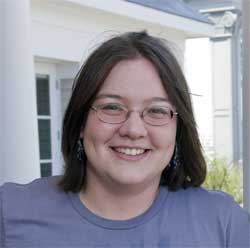 North Kingstown resident set to graduate May 20
North Kingstown resident set to graduate May 20
KINGSTON, R.I. – May 8, 2007 – Occasionally getting dirty usually comes with the territory for students studying environmental sciences. But North Kingstown resident Sarah Shoppell has developed a passion for dirt that some people may consider extreme.
Shoppell is a regional champion at judging the characteristics of soil and looks forward to a career as a soil scientist. She will graduate from the University of Rhode Island on May 20 as the top environmental science student in her class.
“When I took an introductory soil science course, I found it really interesting, so I took a couple more classes,” Shoppell said. “When you take a class where you get to go into the field and dig in the dirt, it’s really fun. There aren’t a lot of people who know much about soil characteristics, and I seemed to have a knack for it.”
For two years, Shoppell participated in soil judging competitions against universities around the country. She competed in California, Utah, New Hampshire and Maine, and earned the 2006 northeast regional soil judging title. The URI soil judging team placed 10th in the 2007 national championships.
“At the competition, you go out into a soil pit – essentially a big hole dug in the ground – and look for characteristics such as color, structure, texture, and redoximorphic features, which are usually iron concentrations and depletions that tell you where the water table is,” she explained. “Here in Rhode Island, the first layer of soil is dark and that’s from organic matter. Then there’s an orange layer with a lot of iron, and below that is the glacial parent material. It tells you a lot about the natural processes that have happened over time.”
Shoppell said that it is important to understand the characteristics of soil because “everything is built on the soil, so you need to know something about it so you can deal with any problems that arise. Can you put a septic system here? Where will the run-off go? Is this a good place to grow crops, or is it going to flood?”
The URI student used her soil knowledge in an internship in the summer of 2005 to help assess the effectiveness of a fertilizer made from biosolids. She collected soil samples throughout the growing season from vegetable fields applied with a variety of fertilizers, grinded the samples up, and tested them in a lab for pH and nitrate. The project assessed which type of fertilizer produced the greatest total weight of vegetables.
Shoppell’s URI career wasn’t all about dirt, though. She volunteered at the Kettle Pond Visitor Center for the U.S. Fish and Wildlife Service, and spent a summer monitoring endangered piping plovers on beaches in South County.
“I would walk the beach, take notes on where the plover nests were, how many babies they had, and keep people and dogs out of the nesting area,” she said. “Spending the summer on the beach was great.”
With graduation approaching, Shoppell is now focused on finding a job.
“My dream job would be working as a soil scientist for the Natural Resources Conservation Service, mapping the soil and integrating soil maps online,” she said. “I’ll probably go to grad school eventually, but in the meantime I want to go into the field and find out if this is really what I want to do. But I’m sure it is. What could be better than a career playing in the dirt?”
URI News Bureau photo by Michael Salerno photography

